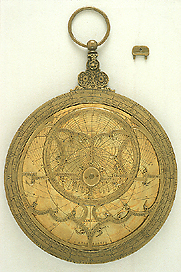
 |
| Catalogue |
 |
 Astrolabe The back plate and the throne appear to be brazed to the rim. The inside of the mater is marked with circles for the tropics and the equator as well as east-west and meridian lines. The throne has the characteristic Hartmann shape: two roses, a rosette, and two fir cones in a triangular layout supported by foliate scrolls. The rete is in the usual Hartmann shape which consists mainly of arcs of circles and split ends of the (half-)circle for the tropic of Capricorn. It has 27 pierced star pointers; the following stars are named: 'CAVDA CETI', 'ANDROMEDA', 'VENTER CETI', 'GORGO', 'NARIS CETI', 'OCULUS [Taurus]', 'CAPRA', 'SI PES ORIONIS', 'CANIS MAIOR', 'PROCION', 'HIDRA', 'COR LEONIS', 'PATERA', 'CAVDA LEONIS', 'CORVUS', 'VRSA', 'SPICA VIRGINIS', 'ARCTUR<US>', 'CORONA, YED', 'CAPUT SERPEN', 'LIRA', 'AQVILA', 'DELPHIN', 'HOLOR', 'HUME EQUI', 'PEGASUS'. The ecliptic is marked with the usual Latin names of the zodiacal signs and is divided into 12 ? 30?, numbered by 10?, divided to 5 ? and on the outer edge into single degrees indicated by serrations. The equinoctial bar is counterchanged six times: on both sides of the ecliptic, between the ecliptic and the tropic of Capricorn and between the ecliptic and the central disc. The reverse of the rete is marked with 'IX' and '9' (upside down) at the intersection of the tropic of Capricorn and the solstitial bar. This number is also to be found on the plates and on the mater at the bottom opposite the throne. The three plates are marked on both sides with circles for the tropics (marked 'CANCER' and 'CAPRICORNUS' and the equator (marked 'EQUATOR'), azimuths for every ten degrees, numbered by 10?, and almucantars every two degrees, numbered by 10. They further bear markings for the unequal hours, numbered in Arabic clockwise 1 to 12, and the astrological houses in the manner of Regiomontanus, numbered in Roman numerals anticlockwise I to XII (additive form for 4, i.e. IIII). Each plate is marked on one side with a '9' and one (1a), two (2a), or three (3a) dots respectively according to the increasing latitudes. The plates are laid out and marked for the following latitudes ('LATITU', 'GRA'): 1a) XXXIX; 1b) XLII (the first four lines for the houses not numbered); 2a) XLV; 2b) XLVIII; 3a) LI; 3b) LIIII. The latitude is repeated in Arabic numerals on the small tongues which locate the plates in the mater. The back bears the following scales (from the outside): A circular altitude scale 90? to 0?, 0? to 90?, 90? to 0?, 0? to 90?, numbered by 5? and divided to single degrees. The single degree scale also serves as a second scale, a regular division of the zodiacal signs to 12 ? 30?, anticlockwise starting with Aries at the equinoctial line, numbered by 5? in Roman and the usual Latin names of the zodiacal signs. Further inside is a calendrical scale, marked with the usual Latin names of the months divided to the corresponding number of days, numbered by 5 and divided to singled days. The equinoxes are at March 101/2 and September 14. The upper part of the space inside these circles is taken up by two hour quadrants with the hour lines numbered 1 to 12. The vacant space bears a double-headed eagle displayed with hats instead of the usual crowns and the heart-shaped shield which would make it the Imperial Eagle. The lower part consists of two shadow scales to the base 12, each marked 'VMBRA RECTA' and 'VMBRA VERSA', numbered by 3 and divided to single digits. Below the shadow scales is the maker's signature 'GEORGIUS HARTMAN NORENBERGE FACIEBAT' and the date 'ANNO MDXXXVII'. The vacant space inside the shadow scales is taken up by the arms of Nuremberg: a crowned harpy on the left side and a double-headed eagle couped palewise and three bends on the right side. The counterchanged alidade does not have any sighting vanes, although one arm appears to have rivets for fixing a vane. The axis of the astrolabe consists of a rivet with a threaded nut pierced with two holes to be turned with a double pointed key. The instrument was purchased from William Wareham in 1880 and is described in F. A. B. Ward, A Catalogue of European Scientific Instruments in the Department of Medieval and Later Antiquities of the British Museum (London, 1981), p. 115, no. 334. Silke Ackermann |



